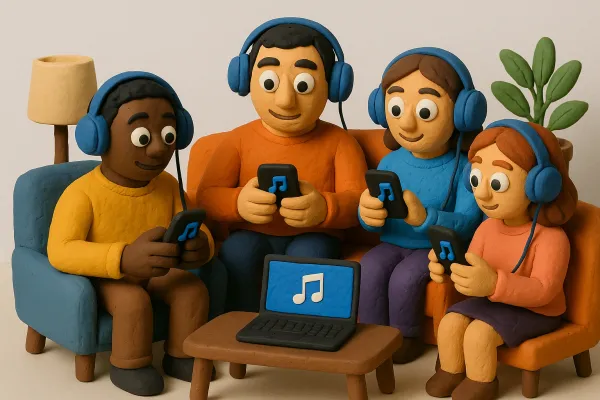Mastering the Music Scene: How to Get on Billboard Chart in 2025

Breaking into the Billboard charts might seem like a distant dream for many musicians. But it's a goal that can become a reality with the right approach. In this article, we'll explore practical steps on how to get on Billboard chart, focusing on strategies that can help you stand out in a crowded industry. From understanding the different types of charts to promoting your music effectively, we've got you covered with tips that can make a real difference in your music career.
Key Takeaways
- Explore various Billboard charts to find the right fit for your music.
- Engage actively with your audience to build a loyal fanbase.
- Choose a strategic release date to maximize your music's impact.
- Utilize social media and streaming platforms for effective promotion.
- Stay motivated and learn from challenges as an indie artist.
Understanding Billboard Charts
Different Types of Billboard Charts
Our journey through the music scene has taught us that not every chart is the same. We see a variety of charts that capture different aspects of music performance. For instance, we like to check out weekly chart trends that give a quick look at how songs and albums are doing each week. Different charts exist to reflect various achievements: one might rank a song’s streaming count while another shows digital downloads or mainstream radio plays. Here's a quick table that sums up some common chart types:
| Chart Type | Frequency | Notable Example |
|---|---|---|
| Mainstream Hits | Weekly | Hot 100 |
| Emerging Artists | Weekly | Billboard Emerging Artists |
| Independent/Indie Collections | Weekly | Top Independent Albums |
We always remind ourselves: Variety in charts gives us more chances to shine.
Importance of Smaller Charts
We believe that smaller charts are a goldmine, especially when you're trying to break into the scene. They might not have the glitz of the big ones, but they can really help us build momentum. Here are a few simple pointers we keep in mind:
- We monitor niche charts to see where our music fits best.
- We focus on engaging with our core audience on these platforms.
- We tailor our releases to capture the feel of these more accessible charts.
Spending time on these less crowded charts can provide us with the genuine listener connection needed to eventually make it big.
How Charts Influence Your Career
Charts aren’t just numbers to us—they directly impact our careers. When our music climbs these rankings, it often leads to real-world opportunities. In our experience, a good chart position helps in several ways:
- More booking opportunities for live shows and events.
- A boost in streaming and sales, reinforcing our market presence.
- Opens doors to collaborations and media features.
Understanding these dynamics helps us adjust our strategy and keep our music evolving with what our listeners love.
Crafting Your Music Strategy
Creating High-Quality Tracks
When we make music, every detail counts. We spend extra time ensuring that every beat and note captures our true style, making our tracks something we’re proud of. This level of care is what really sets us apart.
Some key steps we follow are:
- Putting in extra studio time to fine-tune our sounds
- Experimenting with different instruments and rhythms
- Testing our music with our close circle before a full release
| Activity | Hours Invested | Impact Level |
|---|---|---|
| Melody Creation | 4 | High |
| Instrument Experiment | 3 | Medium |
| Mixing & Mastering | 5 | High |
Engaging with Your Audience
We believe that our fans are like family. Every comment, like, and share has a huge role in pushing our music further. We talk to our listeners as if we were sitting across from them at a coffee shop, keeping the vibe real and laid-back.
Here’s how we do it:
- We reply to messages and comments as often as we can
- We share fun behind-the-scenes moments
- We regularly set up casual Q&A sessions
We’ve found that genuine interactions help build a community where everyone feels included, and that energy really carries us forward.
Choosing the Right Release Date
Deciding when to drop new music isn’t something we take lightly. It’s not just about picking a day on the calendar; it’s about knowing when our fans are most excited. We balance our release dates based on events, past trends, and even a bit of gut feeling.
Our decision process involves:
- Checking social media and fan activity trends
- Analyzing sales data from our past releases
- Planning around other major events in the music world
Timing can make a huge impact, and we've often seen that the best releases happen when every piece falls into place. Also, if you’re curious about who’s shaking things up in this space, check out the latest music icons influencing our scene.
Promoting Your Music Effectively
Utilizing Social Media
We all know that social media is the easiest way for us to share our vibe and connect with fans every day. We get creative, sharing moments from rehearsals, gig prep, and even those silly off-days. Here’s what we typically do:
- Post quick updates about our music and lives
- Share behind-the-scenes snaps
- Engage actively in the comments
Sometimes we even look at simple stats:
| Platform | What We Do | How Often |
|---|---|---|
| Stories and quick clips | Daily | |
| TikTok | Fun short videos | Several times a week |
| Daily chats and updates | Multiple times |
And yeah, we trust that sticking to a solid online routine will get our tunes noticed sooner rather than later. Also, using our artist services often gives our promotional efforts an extra boost.
Building Relationships with Radio Stations
Connecting with local and even online radio spots is another way we play the game. We know that getting our tracks spun on the radio can be that extra nudge our music needs. Here’s our simple three-step plan:
- Reach out with a friendly email or message
- Offer to provide exclusive content or interviews
- Follow up after airplay to say thank you
We keep our interactions genuine and down-to-earth. A quick chat, a thank-you message, and a shared laugh can make all the difference in turning a one-time play into a lasting relationship.
Leveraging Streaming Platforms
Streaming has changed the game for us, and we’re all over it. We set up our profiles with care, chat with playlist makers, and always remind our listeners to add our songs to their personal playlists. To keep our streaming numbers on track, we do things like:
- Check our streaming stats every week
- Talk to curators about feature spots
- Encourage our community to share our tracks during meet-ups and online hangouts
By mixing our creative pushes with a bit of tech-checking, we keep our releases feeling fresh and fun. And yes, a shout-out to our artist services helps us stay on top of our game as we continue to promote our music effectively.
Navigating the Competition
Researching Your Rivals
When we start checking out what other artists are up to, we make sure to track down the numbers and patterns. We like to see how often our rivals drop new tracks, ramp up their social channels, and hit the streaming milestones. Recently, we checked out some numbers by scanning the top execs list for hints on strategy—it's a neat way to see where the industry is leaning.
Here’s a quick look at some points we keep in mind:
| Aspect | What We Notice | How We Could Tweak It |
|---|---|---|
| Release Schedule | Varies a lot | Aim for consistency |
| Social Engagement | Sometimes buzz-worthy | Find our own rhythm |
| Streaming Numbers | Steady, then spikes | Plan release boosts |
Finding Your Unique Sound
We know that copying others won't get us far. Our goal is to come up with a vibe that's all our own. We brainstorm and experiment with different beats and rhythms until something clicks.
- Try mixing unexpected genre elements
- Use sounds that feel fresh to us
- Rely on our fans' feedback for direction
Our unique sound sets us apart in a crowded crowd.
Collaborating with Other Artists
Working with fellow artists opens up a whole new set of ideas. We value the energy that comes from bouncing ideas off one another. It all starts with a chat over creative visions:
- Seek out musicians who share a similar approach
- Reach out casually – sometimes a coffee chat works wonders
- Mix and match styles to see what really resonates
Sometimes, a spontaneous jam session or informal meet-up can lead to our best tracks. It’s all about keeping an open mind and letting ideas flow naturally.
All in all, checking out rivals, carving our own path, and linking up with others are all ways we keep our music fresh and competitive in today’s scene.
Maximizing Your Reach
Using Promotion Services
We all know that getting our music heard isn’t just about putting out tracks; it’s also about smart promotion. When we use promotion services, we stick to simple and clear plans that work. We always keep our strategy simple and honest. One approach that has helped us is to use music marketing tips to pick the right campaigns for our budget and market.
Here are a few points we keep in mind:
- We set a clear budget before starting any campaign.
- We test different ad styles and messages to see what sticks.
- We keep track of every launch so we can make quick, small changes if needed.
Getting on Playlists
There’s something real about seeing your name pop up in playlists—it tells us that our music is connecting. We’ve seen that getting on a good playlist brings not just streams but adds new followers who stick around. To get technical about our steps, here’s a simple table that sums up our progress:
| Strategy | Outcome |
|---|---|
| Targeting curated lists | Increased plays |
| Getting on Spotify lists | Streaming boost |
| Working with radio pluggers | More audience reach |
This data reminds us that every small win builds our overall reach over time.
Engaging with Influencers
We find that working with influencers is another fun and effective way to spread our music. It’s not always easy to match the right vibe with the right person, but our team is all about testing the waters and building genuine ties. Here’s how we go about it:
- We start by looking for influencers who seem to share our style and music story.
- We then strike up laid-back conversations to see if we’re a good fit for collaborating.
- Finally, we track the impact of these partnerships and adjust our efforts as needed.
Every connection we make gives us a little momentum boost, reminding us that even small steps can lead to big changes.
Tracking Your Progress
Monitoring Streaming and Sales
We always start our week by checking our numbers - it feels like a little morning ritual. We look at streaming counts, downloads, and actual sales to see if our music is catching ears. For instance, we put together a quick table like this to see our progress:
| Metric | Last Month | This Month |
|---|---|---|
| Streams | 50K | 60K |
| Downloads | 5K | 6K |
| Sales | 1K | 1.2K |
Using data makes our decisions way smarter. It also helps us spot trends early on, whether a track is winning hearts or needs a bit more push. We even mix in some music exec insights to get a broader picture of what's working industry-wide.
Adjusting Your Strategy
After checking the stats, we often find surprises. Some days, a track might suddenly get a ton of love, while other times, it might fall short. When that happens, we regroup and discuss what could be done differently. Here are a few steps we usually follow:
- Verify audience feedback from social media and streaming charts.
- Tweak our posting times and promotional angles.
- Experiment with different versions of our tracks to see what clicks.
Sometimes, a simple change in the way we promote our music brings in unexpected wins. It keeps everything fresh and gives us a chance to learn from our own playbook.
Setting Realistic Goals
It's one thing to chase numbers, and another to set goals that actually make sense. We break down our targets into simple, tangible steps. For instance, here’s a quick overview of the goals we track:
- Increase overall streams by about 15% over the next two months.
- Grow our fan base steadily by focusing on engaging content.
- Boost listener engagement on every release with clear, achievable targets.
Below is a small table that sums up what we aim for:
| Goal | Current | Target |
|---|---|---|
| Streaming Increase | 30K | 35K |
| Social Media Growth | 20K | 25K |
By keeping our targets realistic, we make sure every step forward counts, and we constantly learn and adjust as we go along.
Overcoming Challenges as an Indie Artist
Staying Motivated
Being indie isn’t always a smooth ride. We know that there will be days when our efforts seem to go unnoticed. Sometimes, staying motivated is our biggest challenge. We know that every setback is a step towards our growth.
Here’s how we keep the momentum:
- Setting small, clear goals that are easy to track.
- Celebrating even the tiniest wins as a team.
- Sharing our progress and struggles openly during our meet-ups.
There are days when it feels like every door is closed, but we remind each other that persistence will eventually pay off.
Plus, we often take inspiration from industry stories like The Weeknd update to remind us of the ups and downs in our field.
Dealing with Rejection
Encountering rejection can sting, but we see it as part of our journey. When someone doesn’t dig our work, we take a moment to learn rather than to feel defeated. Our approach includes:
- Reflecting on the feedback to see what can be improved.
- Discussing our thoughts openly as a group to gather multiple perspectives.
- Using the experience as fuel to make our future projects even better.
We understand that not every idea will be a hit, but facing rejection head-on makes us tougher.
Learning from Feedback
Feedback, when taken the right way, is one of our best improvement tools. We pay close attention to what our audience and peers say, using it to fine-tune our sound. Our process is pretty straightforward:
- Recording our work sessions for a fresh review later.
- Asking for honest opinions from people we trust.
- Adjusting our techniques based on the most common suggestions.
By staying open and listening, we turn even the tough critiques into stepping stones for our next big break.
Being an indie artist can be tough. You face many obstacles, from getting noticed to managing your own music. But don't give up! Every challenge is a chance to grow and learn. If you're looking for tips and support, visit our website. We have resources to help you on your journey!
Wrapping It Up
So, there you have it! Getting on the Billboard charts isn’t just a dream for the big names. With the right moves, you can totally make it happen. Sure, it’s not a walk in the park, but if you stay focused, put in the work, and keep pushing your music, you’ll find your spot on those charts. Remember, start small, aim for those lesser-known charts, and build your way up. It’s all about getting your music out there and connecting with your audience. Keep grinding, stay true to your sound, and who knows? You might just find yourself on Billboard sooner than you think!
Frequently Asked Questions
What are the different types of Billboard charts?
Billboard has various charts, such as the Billboard Hot 100, Billboard Streaming Songs, and Billboard Top Independent Albums. Each chart serves a different purpose and audience.
Why are smaller Billboard charts important?
Smaller charts can help independent artists gain recognition and build a following. They can lead to more exposure and opportunities.
How can I promote my music effectively?
You can use social media, connect with radio stations, and make the most of streaming platforms to get your music heard.
What should I do to stand out in a crowded music scene?
Research your competition, find your unique sound, and consider collaborating with other artists to create something special.
How can I reach a wider audience?
Use promotion services, get featured on playlists, and engage with influencers to help spread the word about your music.
What challenges do indie artists face?
Indie artists often struggle with motivation, rejection, and learning from feedback, but staying focused on your goals can help you overcome these challenges.





